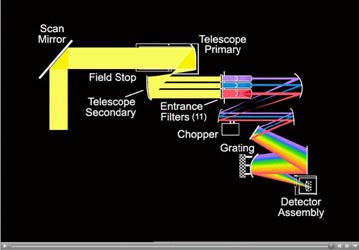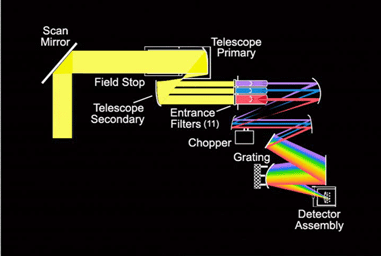
Click on image to view the movieThis animation shows how light energy is collected by the optics system on the Atmospheric Infrared Sounder (AIRS) instrument and digitized.
Energy from the scene is directed by the scan mirror into the AIRS telescope. The telescope collects the Earth scene energy and defines the instantaneous field of view (the 1.1 degree spot on the ground as opposed to the +/- 50 degree earth scan field of view). Filters located at the entrance to the spectrometer separate the energy into 11 different spectral ranges. Optical elements direct this energy to a grating which disperses the energy into a continuum of frequencies. The detector elements then collect discrete spectralranges of (i.e. frequencies) of energy which define the 2378 AIRS infrared spectral channels. The signals from the detectors are digitized, formatted, etc. and transmitted to the spacecraft which broadcast the data to the ground.
About AIRS
The Atmospheric Infrared Sounder, AIRS, in conjunction with the Advanced Microwave Sounding Unit, AMSU, senses emitted infrared and microwave radiation from Earth to provide a three-dimensional look at Earth's weather and climate. Working in tandem, the two instruments make simultaneous observations all the way down to Earth's surface, even in the presence of heavy clouds. With more than 2,000 channels sensing different regions of the atmosphere, the system creates a global, three-dimensional map of atmospheric temperature and humidity, cloud amounts and heights, greenhouse gas concentrations, and many other atmospheric phenomena. Launched into Earth orbit in 2002, the AIRS and AMSU instruments fly onboard NASA's Aqua spacecraft and are managed by NASA's Jet Propulsion Laboratory in Pasadena, Calif., under contract to NASA. JPL is a division of the California Institute of Technology in Pasadena.
More information about AIRS can be found at http://airs.jpl.nasa.gov.

 Planetary Data System
Planetary Data System













